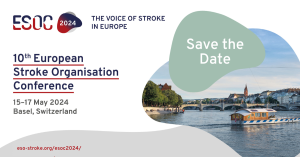 Author: Vojtech Novotny, MD, PhD
Author: Vojtech Novotny, MD, PhD
Bergen Stroke Research Group, Department of Neurology, Bergen, Norway
Twitter: @Vojtech_no
Micro-emboli detection by transcranial Doppler is a non-invasive examination that can identify micro-emboli signals (MES) in the middle cerebral artery. MES are visualized as high-intensity transient signals (HITS) and may represent solid micro-emboli, gaseous particles, or artifacts.1 The clinical significance of micro-emboli detection has been disputed and widespread use of this examination has not been fully established. Importantly, MES may indicate an ongoing asymptomatic cerebral embolization and besides risk stratification, it may also have a therapeutic significance for ischemic stroke. MES are usually detected in the acute phase of ischemic stroke, often decreasing over time either spontaneously or in response to adequate secondary prevention. There is evidence that MES may be used as an independent predictor of early stroke recurrence in some stroke subtypes and possibly as a measure of inadequate secondary prevention.2
Most of the studies aimed at patients with acute ischemic stroke caused by large artery disease. Ipsilateral MES are present in up to 40% of cases with symptomatic internal carotid stenosis (ICAS) and risk features including recent ischemic event, unstable plaque, or high-grade stenosis are strongly associated with MES.2 Patients with symptomatic ICAS along with ipsilateral MES have approximately 15% risk of an early recurrence compared with a 1% risk in patients without MAS and may therefore help in selecting candidates for surgical intervention.3 MES are less commonly detected in asymptomatic ICAS, although their presence may identify high-risk patients within this group.4 The presence of MAS may also select patients for intensified medical therapy. In these patients, dual antiplatelet therapy, as well as intensified statin therapy, may reduce MAS burden.5-6 There are, however, no data on safety and stroke recurrence since big randomized trials are lacking.
Contrary to cardioembolism, MAS are detected rarely in patients with small vessel diseases without proximal emboli source. Approximately 10% of patients with atrial fibrillation have MES detected bilaterally. This number decreases significantly in those who are on anticoagulation.8 Micro-emboli detection in multi-territory ischemic stroke, which is often attributed to cardioembolism, might be a useful examination in the diagnostic work-up and therapeutic approach. Micro-emboli detection may be also used in rare but high-risk stroke etiologies such as active cancer, CNS vasculitis, moyamoya diseases, infective endocarditis, or antiphospholipid syndrome. Initial but also follow-up examinations may facilitate the type, intensity, and duration of therapeutic measures.9
Micro-emboli detection is a relatively simple, repeatable, and low-cost examination which may contribute to risk stratification in the stroke subtypes with a proximal source of embolism. It may also facilitate the therapeutic decision-making and eventual adjustment of secondary prevention. Its potential could be underestimated, and clinical trials are warranted to examine the yield of micro-emboli detection in routine clinical practice.
—
- Devuyst, G., et al. Automatic classification of HITS into artifacts or solid or gaseous emboli by a wavelet representation combined with dual-gate TCD. Stroke, 2001, 32.12: 2803-2809.
- King, A.; Markus, H. S. Doppler embolic signals in cerebrovascular disease and prediction of stroke risk: a systematic review and meta-analysis. Stroke, 2009, 40.12: 3711-3717.
- Spence, J. David, et al. Absence of microemboli on transcranial Doppler identifies low-risk patients with asymptomatic carotid stenosis. Stroke, 2005, 36.11: 2373-2378.
- Zhang, Chunmei, et al. Microembolic signals and carotid plaque characteristics in patients with asymptomatic carotid stenosis. Scandinavian Cardiovascular Journal, 2009, 43.5: 345-351.
- Wong, Ka Sing Lawrence, et al. Clopidogrel plus aspirin versus aspirin alone for reducing embolisation in patients with acute symptomatic cerebral or carotid artery stenosis (CLAIR study): a randomised, open-label, blinded-endpoint trial. The Lancet Neurology, 2010, 9.5: 489-497.
- Markus, Hugh S., et al. Dual antiplatelet therapy with clopidogrel and aspirin in symptomatic carotid stenosis evaluated using doppler embolic signal detection: the Clopidogrel and Aspirin for Reduction of Emboli in Symptomatic Carotid Stenosis (CARESS) trial. Circulation, 2005, 111.17: 2233-2240.
- Safouris, Apostolos, et al. Statin pretreatment and microembolic signals in large artery atherosclerosis. Arteriosclerosis, thrombosis, and vascular biology, 2017, 37.7: 1415-1422.
- Tinkler, Kerry, et al. Asymptomatic embolisation in non-valvular atrial fibrillation and its relationship to anticoagulation therapy. European journal of ultrasound, 2002, 15.1-2: 21-27.
- Kargiotis, Odysseas, et al. The role of transcranial Doppler monitoring in patients with multi‐territory acute embolic strokes: a review. Journal of Neuroimaging, 2019, 29.3: 309-322.
ESOC is Europe’s leading forum for advances in research and clinical care of patients with cerebrovascular diseases. ESOC 2024 will live up to its expectation, and present to you a packed, high quality scientific programme including major clinical trials, state-of-the-art seminars, educational workshops, scientific communications of the latest research, and debates about current controversies. Learn more here.



